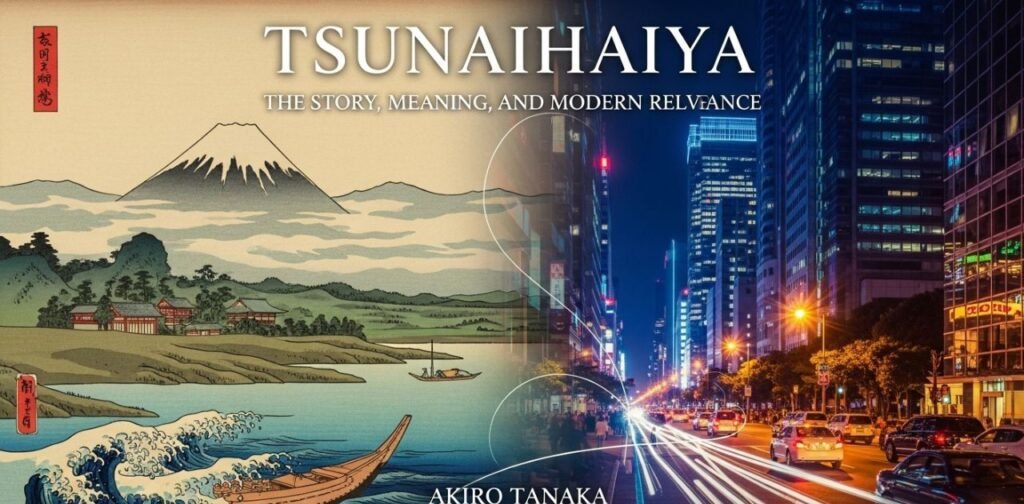What is Tsunaihaiya? Origins and Deeper Meaning
Tsunaihaiya is more than just a name – it represents a unique blend of cultural traditions, symbolism, and artistry. At its core, Tsunaihaiya is known as a jewelry brand that emerged from the collaboration between Japanese designers and Native American artisans. The word itself carries deep meaning, often interpreted as a reference to the “land of the rising sun” and associated with renewal, connection, and spiritual harmony.
The origins of Tsunaihaiya highlight a fascinating cultural exchange. It reflects the craftsmanship of Native American silversmith traditions fused with the precision and aesthetics of Japanese artistry. This blending of two worlds has created jewelry that tells stories, honors traditions, and appeals to those who value authenticity. Each piece is more than decoration; it is a bridge between two heritages that value respect for nature, symbolism, and handmade quality.
The essence of Tsunaihaiya lies in its storytelling. Feathers, suns, natural stones, and hand-carved designs are not chosen randomly. Feathers often symbolize freedom, spirituality, and connection to higher realms. The sun, a recurring motif, represents rebirth, strength, and energy. Stones like turquoise, onyx, or lapis carry meanings tied to healing, protection, and balance. When these motifs are combined with meticulous Japanese craftsmanship, the result is jewelry that is both meaningful and visually captivating.
At a deeper level, Tsunaihaiya also embodies the values of respect and harmony. It is not about mass production or flashy trends but about creating lasting, thoughtful art. In an age where many people seek authentic connections and cultural respect, Tsunaihaiya stands as a reminder that artistry can serve as a bridge between different traditions while maintaining dignity and meaning.
Design Aesthetic and Craftsmanship of Tsunaihaiya
One of the most captivating aspects of Tsunaihaiya is its design philosophy. The jewelry is characterized by its fusion of rugged Native American symbolism with refined Japanese minimalism. This unique aesthetic allows the pieces to feel both grounded in tradition and modern enough for contemporary fashion.
The product lines include bracelets, bangles, rings, pendants, and necklaces, often made from sterling silver and natural stones. A hallmark of the brand is the feather motif, carefully hand-stamped and engraved into silver. Feathers are often elongated, layered, or curved, reflecting not just artistry but the symbolism of freedom and guidance. The sun motif appears in many designs, showcasing rays and circular forms that connect wearers to vitality and cosmic cycles.
Another element that sets Tsunaihaiya apart is its emphasis on handcrafted work. Unlike mass-produced jewelry, every item is individually crafted, meaning that no two pieces are exactly alike. Slight variations, textures, and imperfections are celebrated as proof of authenticity and human touch. This mirrors the Japanese appreciation for wabi-sabi – the beauty found in imperfection.
The materials chosen also highlight the brand’s philosophy. Silver is often left slightly oxidized or textured, creating depth and contrast. Stones like turquoise, highly significant in Native traditions, add vibrant color and natural energy to the designs. Some pieces experiment with mixed metals, incorporating gold accents or layered finishes.
Overall, the design aesthetic of Tsunaihaiya appeals to those who seek jewelry that tells a story. It is not just about wearing an accessory, but about carrying meaning, heritage, and artistry. Each piece becomes a personal talisman – something that holds symbolic value for the wearer, whether as a connection to cultural roots, a reminder of nature, or simply an appreciation for true craftsmanship.
Cultural Context and Interpretations
Tsunaihaiya is often surrounded by cultural curiosity and, sometimes, misconceptions. Because the name sounds unique and carries symbolic weight, people sometimes assume it refers to a traditional ritual, ancient chant, or spiritual practice. While the word does have echoes of cultural expression, especially with its rhythmic sound, it is primarily the identity of a jewelry brand that celebrates cross-cultural artistry.
The brand’s creation is rooted in genuine collaboration, which is important to note. Indigenous designs and motifs have often been appropriated without credit, but Tsunaihaiya sought to avoid this by working directly with Native artisans while honoring Japanese artistry. This makes it an example of cultural appreciation rather than appropriation.
Still, there are challenges. Some may misinterpret the pieces as purely traditional Native American jewelry, when in fact they are modern reinterpretations. Others may mistakenly think the name refers to a sacred chant or spiritual ritual. While many of the motifs hold spiritual significance, the jewelry itself is positioned as artistic and wearable rather than ceremonial.
The key to understanding Tsunaihaiya lies in appreciating it as a fusion project. It is not pretending to be purely Indigenous or purely Japanese; instead, it acknowledges both roots. Feathers, suns, and turquoise stones remain true to Native symbolism, while the balance, form, and finish carry Japanese sensitivity. Together, this creates jewelry that feels universal yet respectful of its origins.
For wearers, this cultural dimension adds depth. Buying and wearing Tsunaihaiya is not just about owning a piece of silver jewelry – it is about supporting cross-cultural artistry, honoring traditions, and being mindful of the stories that objects carry.
Why Tsunaihaiya Resonates in Modern Times
The modern jewelry market is saturated with mass-produced accessories, making it harder for brands to stand out. Tsunaihaiya has carved a distinct space because it offers what many consumers today crave: authenticity, story, and craftsmanship.
In today’s fashion landscape, trends like slow fashion and conscious consumption have become central. People are increasingly questioning where their products come from, who makes them, and what they represent. Tsunaihaiya fits neatly into this demand. Its handcrafted pieces, cultural respect, and symbolic designs provide an alternative to disposable, trend-based jewelry.
Another reason for its appeal is its fusion identity. Global consumers love cultural blends when done respectfully. Tsunaihaiya provides exactly that – a balance of Native American heritage and Japanese artistry. It feels authentic yet globally accessible, appealing to those who want unique pieces with a story to tell.
From a market perspective, Tsunaihaiya occupies a mid-premium niche. It is not luxury jewelry priced at unattainable levels, but it is also not cheap fashion jewelry. This balance attracts collectors, design enthusiasts, and anyone willing to invest in jewelry that carries meaning. The handcrafted quality also ensures longevity, which aligns with eco-conscious buyers who prefer items that last.
Culturally, Tsunaihaiya resonates with the values of connection, spirituality, and artistry. The symbolism of feathers, suns, and natural stones appeals to universal human emotions – freedom, hope, renewal, and balance. This makes the jewelry not just beautiful but emotionally powerful, which is why it continues to gain recognition.
Frequently Asked Questions (FAQs)
1. What does the word Tsunaihaiya mean?
Tsunaihaiya is often understood as a poetic reference to the land of the rising sun, symbolizing Japan. It also reflects renewal, energy, and cross-cultural connection.
2. Is Tsunaihaiya an ancient ritual or chant?
No. While the word has a rhythmic and cultural sound to it, Tsunaihaiya is primarily the name of a jewelry brand. Some motifs carry spiritual meaning, but the brand itself does not represent a traditional ritual.
3. Who created Tsunaihaiya jewelry?
It was born from collaboration between Japanese designers and Native American artisans. The goal was to merge the silversmith traditions of Indigenous culture with Japanese craftsmanship.
4. What materials are commonly used in Tsunaihaiya pieces?
Most items are handcrafted from sterling silver, often combined with turquoise, onyx, lapis, or other natural stones. Mixed metals and gold accents also appear in some designs.
5. Why are feathers and sun symbols common in Tsunaihaiya jewelry?
Feathers symbolize freedom, spirituality, and higher connection, while suns represent vitality, rebirth, and strength. Both are important in Native traditions and carry universal meanings.
6. Is Tsunaihaiya jewelry mass-produced?
No. Each piece is individually handcrafted, often in small batches. This ensures uniqueness and authenticity, with slight variations in texture and detail.
7. Can anyone wear Tsunaihaiya jewelry?
Yes. The brand was created to be inclusive and meaningful for all. Wearing Tsunaihaiya is not limited to any culture but should be approached with respect for the traditions and stories behind the designs.
8. How much does Tsunaihaiya jewelry usually cost?
It falls in the mid-premium range. Prices reflect the use of sterling silver, natural stones, and handcrafted detail, making them more valuable than mass-produced accessories.
Conclusion: The Future of Tsunaihaiya
Tsunaihaiya is not just about jewelry – it is about the meeting of worlds. By combining Native American silversmith traditions with Japanese artistry, it has created a unique aesthetic that feels both timeless and modern. Its motifs of feathers, suns, and natural stones speak to universal human values: freedom, strength, and connection to nature.
In a global era where people seek authenticity and meaning, Tsunaihaiya has positioned itself as more than a brand. It is a symbol of cultural respect and collaboration. By celebrating traditions without exploiting them, it demonstrates how artistry can bridge communities rather than divide them.
Looking ahead, Tsunaihaiya has strong potential to grow internationally. As more people discover the beauty of handcrafted jewelry with cultural depth, the brand’s story will resonate even further. The challenge will be to maintain authenticity, honor its origins, and continue innovating in design without losing its identity.
The future of Tsunaihaiya lies not only in its products but in the values it represents – respect, craftsmanship, and the power of cultural exchange. In a world that increasingly values stories behind objects, Tsunaihaiya shines as a reminder that jewelry can be more than an accessory; it can be a statement of identity, heritage, and harmony.



